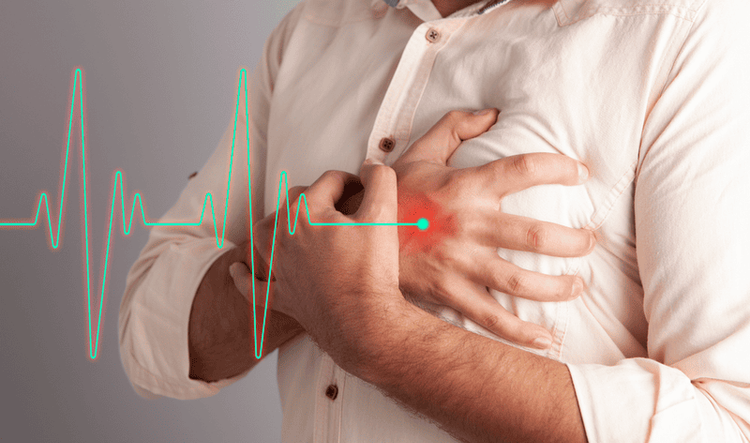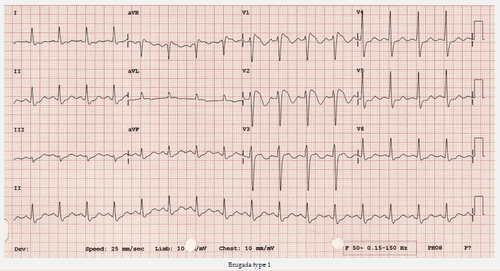This is an automatically translated article.
Brugada syndrome is a rare genetic disorder. The disease affects heart rhythms and can cause them to become too fast or arrhythmia. When there is an arrhythmia, the heart cannot ensure the function of pumping blood to other organs in the body. If someone in the family is diagnosed with Brugada syndrome, other members need to see a specialist for advice and order laboratory tests to diagnose and detect the disease, in which genetic testing is also necessary. should be considered.1. Overview of Brugada syndrome
Brugada syndrome is one of the most common causes of sudden death due to cardiovascular disease. The average incidence is about 5/1000 people, including young and healthy people. Brugada syndrome occurs most commonly in Japanese and South Asian countries.
Brugada syndrome is rare but has the potential to cause life-threatening arrhythmias. People with this syndrome are at increased risk for arrhythmias that originate in the ventricles located in the lower part of the heart.
Treatments for Brugada syndrome focus on preventive measures such as avoiding drugs that aggravate the condition and reducing fever. In necessary cases, treatment also requires the use of medical equipment such as defibrillators.
2. Is Brugada syndrome dangerous?
Brugada syndrome is rare but very dangerous. This is the cause of many sudden cardiovascular-related deaths and can occur in historically healthy individuals. Patients with complications of Brugada syndrome need to be treated promptly if they want to preserve the patient's life. Common complications are:
Sudden cardiac arrest: if not treated immediately, the patient can suddenly stop the heart, stop breathing and lose consciousness. This complication usually occurs during sleep and has a high mortality rate. However, with quick and accurate first aid, the patient's life can still be saved. Syncope: If you have been diagnosed with Brugada syndrome before and experience fatigue or fainting, call 911 immediately.

Ngất là một trong những biến chứng của hội chứng Brugada
3. Causes of Brugada's Syndrome
Brugada syndrome is a severe arrhythmia. In a normal person, each heartbeat is initiated by electrical impulses emitted by special cells in the right atrium. The conduction channels are responsible for sending these signals to other parts of the heart and helping the heart to contract in synchrony.
For people with Brugada syndrome, an abnormality in the conduction channels causes the heart to beat abnormally fast and out of control, eventually leading to a life-threatening arrhythmia called ventricular fibrillation.
The result of this condition is that the heart does not pump enough blood to the rest of the body. The person may faint if the irregular heartbeat is present for only a short period of time. Sudden death occurs when the arrhythmia persists and does not stop.
Causes of Brugada syndrome include:
Structural abnormalities inside the heart. This cause is often difficult to detect and diagnose. An imbalance of chemical mediators helps to spread electrical signals inside the body. Using certain medications for high blood pressure, depression, or chest pain Cocaine use Raises blood calcium levels Blood potassium levels too high or too low.
4. Who is at risk for Brugada syndrome?
Brugada syndrome can appear and cause dangerous complications without warning. Risk factors for Brugada syndrome increase the likelihood of developing the disease but are not a direct cause of its occurrence. People with the following characteristics have a higher risk of developing Brugada syndrome:
Family history of Brugada syndrome: Brugada syndrome is sometimes reported to be passed on to the next generation. If other family members have Brugada syndrome, your risk is higher than other people. About 30% of patients are found to have abnormalities in the gene that plays a role in maintaining a normal heart rhythm.

Hội chứng Brugada có thể do di truyền
Male gender: Men are more often diagnosed with Brugada syndrome than women. Race: Brugada syndrome is more common in Asian people, especially in Japan and countries in South Asia. Fever: Fever is not the cause of Brugada syndrome, but it can irritate the heart and cause complications such as fainting or sudden cardiac arrest in people with Brugada syndrome, especially in children.
5. Signs to recognize Brugada syndrome
Many people with Brugada syndrome are unaware because Brugada syndrome often causes no noticeable symptoms.
Signs and symptoms that may be associated with Brugada syndrome include:
Dizziness Fainting Shortness of breath, yawning, especially often during sleep, at night Anxiety palpitations Irregular heartbeat or heart Tachycardia Convulsions A prominent sign of Brugada syndrome is an abnormal electrocardiogram. Based on electrocardiographic features, Brugada syndrome is divided into 3 types:

Nhịp tim không đều là dấu hiệu của hội chứng Brugada
Brugada syndrome type 1 has an ST elevation of at least 2 mm (0.2 mV) above the J-point elevation and a descending ST segment followed by a negative T wave. Brugada syndrome type 2 has a J-point elevation of at least 2 mm with a saddle shape and an ST elevation of at least 1 mm with a positive or biphasic T wave. Brugada syndrome type 2 can sometimes be seen in otherwise healthy individuals. Brugada syndrome type 3 has a cruciform pattern (such as type 1) or a saddle pattern (such as type 2), with J-point elevation less than 2 mm and ST elevation less than 1 mm. Type 3 is not uncommon in healthy subjects. According to the recommendations, only the ECG feature of Brugada syndrome type 1, which occurs spontaneously or after drug administration, can be used to confirm the diagnosis of Brugada syndrome because of the Brugada syndrome type 2 and the Brugada type 3 is also common in people who do not have the disease.
The signs and symptoms of Brugada syndrome have many similarities with other arrhythmias. It is important for patients to see a doctor for timely detection and diagnosis of Brugada syndrome or other arrhythmias.
If fainting is present and is suspected to be related to cardiovascular disease, the patient should be taken to the nearest emergency medical facility. In case there is a family member diagnosed with Brugada syndrome such as a parent, sibling or child, you need to consult a doctor for advice and order tests to detect Brugada syndrome. if.
Currently, Cardiovascular Center - Vinmec International General Hospital is one of the leading centers in the country for examination, diagnosis, screening and treatment of cardiovascular diseases. Vinmec not only has the convergence of a team of experienced and reputable leading experts in the field of surgical treatment, internal medicine, interventional cardiac catheterization, but also has a system of modern equipment, on par with The most prestigious hospitals in the world such as: MRI 3 Tesla (Siemens), CT 640 (Toshiba), high-end endoscopy equipment EVIS EXERA III (Olympus Japan), high anesthesia system Avace level, Hybrid operating room according to international standards... Especially, with the space designed according to 5-star hotel standards, Vinmec ensures to bring patients the most comfortable, friendly and reassuring comfort. .
Please dial HOTLINE for more information or register for an appointment HERE. Download MyVinmec app to make appointments faster and to manage your bookings easily.
References: webmd.com, mayoclinic.org













